Llanelly is a parish in the ancient county of Breconshire, which roughly covers the area of the Clydach Gorge, west of Abergavenny, east of Brynmawr and south of Crickhowell. The parish contains the settlements of Llanelly Hill, Blackrock, Clydach, Maesygwartha and Gilwern and developed as a result of coal mining and limestone quarrying for the nearby ironworks including Clydach ironworks and the Ebbw Vale ironworks. The centre of religious life in the parish is the ancient Church, which is dedicated to St. Elli. Within the Church is the parish war memorial, which takes the form of a fine stained glass memorial window, containing the names of the fallen parishioners of the Great War. Plaques have been added below the window to commemorate other men who were omitted from the original memorial window, whilst another plaque commemorates the parishioners who fell during the Second World War.
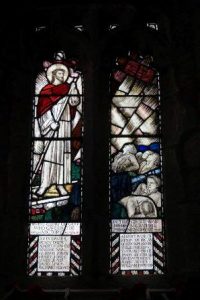
The Great War, 1914-1918
Clifford Owen Bowcott, Trooper, 66, Australian Light Horse. Clifford was born in 1890, the son of John Bowcott and Mary Bowcott (nee Jones), of Stonesfield, Monmouth Road, Abergavenny. His mother was from Llanelly, the daughter of Philip and Ann Jones, of the Navigation Inn, Llanelly. The family had moved to Llanfoist Farm, at Llanfoist by 1911 and Clifford worked there for his parents. He then decided to start a new life in Australia and embarked aboard the steamship SS Ballarat at London for Sydney on 23 Jan 1913. Clifford found work as a stockman upon arriving in Australia, but following the outbreak of war enlisted at Townsville, Queensland into the 5th Australian Light Horse Regiment on 21 September 1914. The 5th Light Horse Regiment was raised in Brisbane in September 1914, entirely from men who had enlisted in Queensland, and became part of the 2nd Light Horse Brigade. The brigade sailed from Sydney on 21 December 1914 and disembarked in Egypt on 1 February 1915. As a cavalry unit, the light horse was considered unsuitable for the initial operations at Gallipoli but were subsequently deployed without their horses to reinforce the infantry. The 2nd Light Horse Brigade landed in late May 1915 and was attached to the 1st Australian Division. Clifford was wounded in the head on 27 June and was evacuated from the peninsula aboard the Hospital Ship Sicilia, which took him, together with several hundred other wounded men, to No 2 General Hospital in Cairo. Upon recovering, he arrived back at Gallipoli on 2 October to re-join his unit. Clifford was severely wounded on 29 November, during a terrible day of snowstorms. He was evacuated aboard another Hospital Ship to the 19th General Hospital at Alexandria but died of his wounds there on 5 December 1915. The 25-year-old was buried in Alexandria (Chatby) Military and War Memorial Cemetery, Egypt. His brother, Frederick Bowcott, was killed in France in 1918. Neither man is commemorated at St. Elli’s Church.
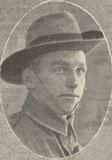
Frederick Bowcott, Sergeant, 57930, Royal Welsh Fusiliers. Frederick was born in 1897, the son of John Bowcott and Mary Bowcott (nee Jones), of Stonesfield, Monmouth Road, Abergavenny. His mother was from Llanelly, the daughter of Philip and Ann Jones, of the Navigation Inn, Llanelly. The family had moved to Llanfoist Farm, at Llanfoist by 1911 and Frederick worked on the family farm upon leaving school. He enlisted into the South Wales Borderers at Newport in the spring of 1915, but upon being drafted to France about twelve months later, was posted to the 9th Battalion, Royal Welsh Fusiliers, which was attached to 58 Brigade, 19th (Western) Division. The division saw heavy fighting during the opening phases of the Somme offensive in July 1916 and then fought through the Somme Battles of Poziéres and the Ancre in 1916. The Division wintered on the Somme and in February followed the German withdrawal to the Hindenburg Line. During the middle of March 1917, the Division was relieved from the line and began to move north, taking over positions in the Ypres Salient, and on 7 June took part in the assault on Messines Ridge, which was famously preceded by the blowing of a series of 19 huge underground mines. The 19th Division saw heavy fighting during the battle, then enjoyed a short spell in reserve before moving back into the line on 11 September, taking over a section of trenches running from the Ypres-Comines Canal to Belgian Wood. On 20 September the Division attacked past Hollebeke Chateau, to Hessian Wood, suffering terrible casualties. The Division wintered in the Cambrai sector, following the closure of the Battle of Cambrai, and was holding a section of the line in the Flesquières Salient. On 21 March 1918 the Germans launched the first of three offensives on to the section of the front running from Flesquières to St. Quentin, and the 19th Division was thrown into desperate fighting as it was pushed back over the coming days. The battered Division was then moved to the Messines sector to rest, but on 11 April became caught up in the second phase of the German offensive, which had been launched along the Lys Valley on 9 April, and again became caught up in desperate fighting. The remnants of the Division were moved south to the Aisne sector to rest and rebuild, but by sheer bad luck, the Germans third, and last, offensive was launched here on 27 May 1918, and the Division was once more caught up in desperate fighting. Frederick was killed in action near Poilly, during another day of ferocious fighting on 30 May 1918. The 22-year-old has no known grave and is commemorated on the Soissons Memorial, France. His brother, Clifford Bowcott, died of wounds suffered at Gallipoli in 1915. Neither man is commemorated at St. Elli’s Church.
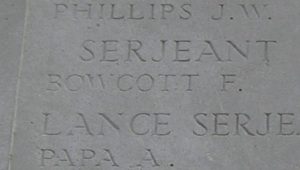
Levi Coleman, Private, 121, Monmouthshire Regiment. Levi was the son of Joseph and Sarah Coleman of Waenlafra, Llanelly Hill, Breconshire. He married Mary Smith at St. Elly’s Church, Llanelly Hill on 2 August 1901 and the couple set up home at 163, New Gladstone Street, Abertillery. Levi worked as a collier for many years prior to the war. He had enlisted at Abergavenny into the 3rd Battalion, Monmouthshire Regiment in about 1908 and continued to serve over the coming years. The battalion mobilised at Abergavenny attached to the Welsh Border Brigade, Welsh Division, before moving to Pembroke Dock. On 10 August 1914 the Division moved to Oswestry before moving to Northampton, then spent Christmas at Bury St. Edmunds before moving to Cambridge. In February 1915 the 3rd Monmouth’s left the Welsh Division and landed in France on 14 February, before moving to the Ypres Salient. On 3 March 1915 the battalion joined 83 Brigade, 28th Division. On 8 April the 3rd Monmouth’s relieved a French Division in the sector east of the Polygon Wood to begin its first tour in the trenches. The battalion was relieved four days later, and marched to billets in Ypres, then on 17 April relieved the 5th King’s Own in the front line, to begin a spell which would last for 17 days without relief. On 22 April, just to the north, the Germans launched the first gas attack of the war upon French Colonial troops at Gravenstafel, heralding the opening of the Second Battle of Ypres. The fighting remained to the north of Polygon Wood until 3 May, when the Germans widened their attacks and the Polygon Wood sector was evacuated by the 28th Division, which fell back on the G.H.Q. line at Potijze. Over the coming days their new positions were shelled mercilessly, then on 8 May the Germans attacked. Despite heavy losses the Division held firm and later that day three Companies of the 3rd Monmouth’s moved back into billets at Vlamertinghe, leaving B Company in the line. By now casualties had become so severe that on 10 May a Composite Battalion was formed from remnants of 83 Brigade, under Lt Col Gough, and proceeded to the G.H.Q. line at Potijze. Over the coming days their new positions were shelled mercilessly, then on 8 May the Germans attacked. Despite heavy losses the Division held firm and later that day three Companies of the 3rd Monmouth’s moved back into billets at Vlamertinghe, leaving B Company in the line. By now casualties had become so severe that on 10 May a Composite Battalion was formed from remnants of 83 Brigade, under Lt Col Gough, and proceeded to the G.H.Q. line at Potijze. During the coming weeks, all three battalions of the Monmouth’s, which were all at Ypres, suffered such heavy losses that on 27 May they were merged together at Vlamertinghe in 84 Brigade, 28th Division. On 11 August 1915 the individual battalions resumed identity and the 3rd Monmouth’s re-joined 83 Brigade, before becoming the Pioneer Battalion to the 49th (West Riding) Division in September 1915. The 3rd Monmouth’s were carrying out work at Elverdinghe on 29 December 1915 when four 17” British shells fell short into their positions, killing and wounding some 69 men. Levi was killed instantly when one of the shells burst near him. The 39-year-old is buried in Ferme Olivier Cemetery, Ieper, Belgium, in what amounts to a mass grave. Levi is also commemorated on the Abertillery war memorial. His name is not among those on the Memorial window in St. Elli’s, but has been added on the later plaque below.
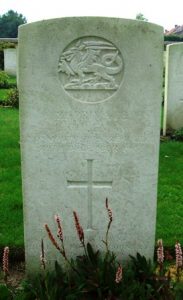
David James Davies, Lance Corporal, 10523, South Wales Borderers. David was born in 1887, the son of Edward Davies and Ann Davies, of Upper Gelly, Llanelly Hill. The family later moved to 60, King Street, Brynmawr. David had left home as a young man to enlist into the army and by 1911 was in South Africa with the 2nd Battalion, South Wales Borderers. The battalion was in Tientsin, China at the outbreak of war and took part in a famous operation with the Japanese against the German held port of Tsingtao on 23 September. On 4 December the battalion embarked at Hong Kong and landed at Plymouth on 12 January 1915, entraining for Rugby to join 87 Brigade, 29th Division. On 17 March 1915 the battalion sailed from Avonmouth with the Division, arriving at Alexandria on 29 March, before moving to Mudros. On 25 April 1915 the Division landed at Cape Helles, Gallipoli, as part of the original landing force which had been despatched to try and seize the Dardanelles Straits and force Turkey out of the war. The invasion forces failed to break the Turkish defences and the campaign became bogged down, so after an arduous eight months on the Peninsula the 29th Division was evacuated to Egypt on 11 January 1916, before being transferred to the Western Front, landing at Marseilles on 15 March and entraining for the Somme sector, taking up positions near Beaumont Hamel, facing Y-Ravine. The Division had an arduous time here too over the coming months, before taking part in a suicidal assault on 1 July 1916, on the opening day of the Somme offensive. The 2nd SWB alone suffered some 384 casualties on that day alone. Although severely depleted, the Division remained in the line here over the coming weeks, in trying conditions. The Division was then pulled out of the line to rest and rebuild before moving back into the line and taking part in the latter stages of the Somme offensive. The Division wintered on the Somme, taking part in the advance which followed the German withdrawal to the Hindenburg Line. At the beginning of April, the entire 29th Division moved out of the Somme sector to the Arras sector, and by 9 April took over a section of the line facing Monchy-le-Preux. The Division then began to prepare for the forthcoming Battle of Arras. At dawn on 23 April 1917, the Division launched an assault on Monchy-le-Preux. The 2nd SWB captured the front-line German trench and advanced some 300 yards beyond before consolidating its gains. David was killed in action at some time during the day. The 29-year-old has no known grave and is commemorated on the Arras Memorial, France. David is also commemorated on the Brynmawr war memorial. His name is not among those on the Memorial window in St. Elli’s, but has been added on the later plaque below.
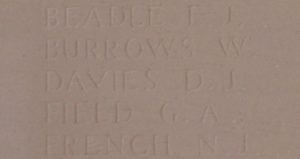
John Davies, Private, 37041, King’s Own (Royal Lancaster Regiment). John was the son of Joseph and Mary Ann Davies, of 5, Castle Road, Gilwern. He enlisted into the army early in 1918 and in March 1918 was drafted to France, joining the 8th Battalion, King’s Own (Royal Lancaster Regiment). The battalion was attached to 76 Brigade, 3rd Division and was holding a sector of the line near Hinges when John joined its ranks. On 9 May the battalion took up positions in the line near Locon and over the coming weeks rotated between Locon, Hinges and rest periods in Chocques. During the second week of August the Division began to move southwards to the Arras sector, in preparation to join the forthcoming offensive and took over positions at Berles-au-Bois. The great offensive opened at dawn on 21 August 1918 and the 8th King’s assaulted the German lines defending Courcelles. John was killed in action during an assault against the railway embankment at Courcelles that day. The 19-year-old has no known grave and is commemorated on the Vis-en-Artois Memorial, Haucourt, France.
Percy William Allen Drew, Private, 1933, South Wales Borderers. Percy was the son of William Drew and Charlotte Louisa Drew (nee Price), of Mill Street, Crickhowell. He worked as a groom prior to enlisting at Brecon into the 1st Brecknockshire Battalion, South Wales Borderers. The battalion had mobilised at Brecon attached to South Wales Brigade, Welsh Division, moving to Pembroke Dock and then Dale. On 29 October 1914 the battalion sailed from Southampton for Bombay, before transferring to Aden, where the battalion took part in a tragic crossing of the desert which saw a number of men die of heatstroke. In August 1915 the battalion embarked for India, arriving at Bombay, before spending the rest of the war on garrison duties in the country. Percy took ill soon after arriving in India and died in Colaba on 21 August 1915. The 20-year-old was buried in Suwri Cemetery, Bombay, but at some time afterwards the military graves were exhumed from there and reburied in a mass grave in Kirkee War Cemetery. As a result, Percy is commemorated on the Kirkee 1914-1918 Memorial, India.
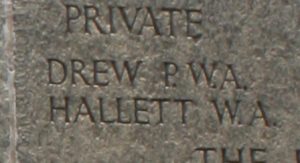
Albert Edward Flowers, Private, 33248, South Wales Borderers. Albert was born in Harpurhey, Manchester in 1893, the son of John Edwin and Anna Flowers (nee Bendall). His father was originally from Maesteg and after the turn of the century the family had moved to The Common, Gilwern. Albert’s mother died in 1910 and his father remarried to Catherine Ann Williams the following year. Albert worked as a surfaceman at the Six Bells Colliery prior to the war. He enlisted at Abertillery into the South Wales Borderers and was posted to Colwyn Bay to join the 11th Battalion, South Wales Borderers. In August 1915 the battalion moved to Hazeley Down, Winchester attached to 115 Brigade, 38th (Welsh) Division and embarked for France on 4 December, landing at Le Havre. The Division moved to the Nursery Sector near Fleurbaix for trench initiation alongside the Guards Division. Albert did not embark with the battalion but was drafted out to France in the Spring of 1916. The Division then held a sector of the line near Cuinchy before marching south to the Somme sector in June 1916 to take part in the assault on Mametz Wood. The first attack on the wood was launched on a two-battalion front on 7 July, with the 16th Welsh and the 11th SWB charging across the open expanse of Death Valley towards the wood. The two battalions became mown down by machine-gun fire and the initial assault failed. Albert was killed in action during the assault that day. The 21-year-old is buried in Flatiron Copse Cemetery, Mametz, France.
Walter James Isaac, Private, 28840, Somerset Light Infantry. Walter was the son of Benjamin Isaac and Mary Isaac (nee Griffiths), of Tyr Common, Gilwern. He worked as a Grocer at the Central Supply Stores, Llanbradach prior to the war. Walter married Lottie Maria Reed at Bedwellty Parish Church on 22 September 1915. He enlisted at Caerphilly into the Monmouthshire Regiment soon afterwards and upon being drafted to France in the autumn of 1917 was transferred to the 8th Battalion, Somerset Light Infantry, which was attached to 63 Brigade, 37th Division. Walter would have joined the battalion at Ypres, where the Division was taking part in the latter stages of the Passchendaele offensive. The Division wintered in the Ypres Salient, then in February 1918 was relieved, spending a short while behind the lines in reserve before moving south on 29 March to bolster the thinly stretched British lines on the Ancre, following the heavy losses suffered following the launching of the German offensive of 21 March. The Division took up positions on the Ancre soon after its arrival and on 5 April 1918 launched a counterattack against the Germans at Gommecourt, to attempt to regain some lost ground. The 8th Somerset’s were to have been supported in their assault to the southeast of Gommecourt by eight tanks, but they failed to arrive, so the infantry charged without support. Their first objective was carried but the battalion encountered fierce resistance at Rossignol Wood and suffered heavy casualties. Walter was killed in action during the days fighting. The 33-year-old is buried in Gommecourt British Cemetery No. 2, Hébuterne, France.
George Jones, Private, 9793, South Wales Borderers. George was born in Gilwern in 1884, the son of Thomas Alfred Jones and Mary Elizabeth Jones. He had enlisted into the South Wales Borderers as a young man and by 1911 was serving with the 1st Battalion, South Wales Borderers at Chatham. By the time that war erupted, George was in Tientsin, China, serving with the 2nd Battalion, South Wales Borderers. The battalion took part in a famous operation with the Japanese against the German held port of Tsingtao on 23 September. On 4 December the battalion embarked at Hong Kong and landed at Plymouth on 12 January 1915, entraining for Rugby to join 87 Brigade, 29th Division. On 17 March 1915 the battalion sailed from Avonmouth with the Division, arriving at Alexandria on 29 March, before moving to Mudros. On 25 April 1915 the Division landed at Cape Helles, Gallipoli, as part of the original landing force which had been despatched to try and seize the Dardanelles Straits and force Turkey out of the war. The invasion forces failed to break the Turkish defences and the campaign became bogged down, so after an arduous eight months on the Peninsula the 29th Division was evacuated to Egypt on 11 January 1916, before being transferred to the Western Front, landing at Marseilles on 15 March and entraining for the Somme sector, taking up positions near Beaumont Hamel, facing Y-Ravine. The Division had an arduous time here too over the coming months, before taking part in a suicidal assault on 1 July 1916, on the opening day of the Somme offensive. The 2nd SWB alone suffered some 384 casualties on that day alone. George was transferred back to the 1st Battalion, South Wales Borderers at some point. The battalion was heading for the Somme from Loos, attached to 3 Brigade, 1st Division, when the Somme offensive opened, and by 10 July had reached Albert. On 15 July the battalion left Albert for Lozenge Wood, preparing to move into the line near Mametz Wood and supported an assault by the 2nd Welsh on Bazentin Ridge the following day. After three days of fighting, the 1st SWB was relieved on 19 July and had a brief rest before moving back to Lozenge Wood by 23 July, then moved into the front line near Contalmaison. George was killed in action during heavy fighting at Munster Alley on 25 July 1916, while the Australians were assaulting Pozieres, just to the north. The 32-year-old has no known grave and is commemorated on the Thiepval Memorial, France. His soldiers war gratuity was left to Miss Eva Ann Botterill, of 186, Lawford Road, New Bilton, Rugby. His name is not among those on the Memorial window in St. Elli’s, but has been added on the later plaque below.
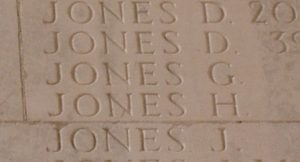
Gurnos John Jones, Private, 1518, South Wales Borderers. Gurnos was the son of Thomas and Emily Jones, of Maesgwartha, Gilwern. He worked as a labourer in a stone quarry prior to the war. Gurnos enlisted into the Brecknockshire Battalion, South Wales Borderers at Brecon prior to the war. The battalion had mobilised at Brecon attached to South Wales Brigade, Welsh Division, moving to Pembroke Dock and then Dale. On 29 October 1914 the battalion sailed from Southampton for Bombay, before transferring to Aden, where the battalion took part in a tragic crossing of the desert which saw a number of men die of heatstroke. Gurnos was among several men of the Brecknock’s who died of heatstroke on 4 July 1015. The 23-year-old has no known grave and is commemorated on the Heliopolis (Aden) Memorial, Egypt.
Henry Jones, Private, 59615, Machine Gun Corps. Henry was born in 1898, the son of Evan Jones and Mary Ann Jones (nee Price), of Mount Pleasant, Llanelly Hill. He left home to work as a coal hewer at Huddersfield prior to the war. Henry enlisted at Halifax into the Durham light Infantry, then trained as a specialist machine-gunner before being transferred to the Machine Gun Corps. Henry was drafted to France in December 1916, then entrained for the southern port of Marseilles, where he boarded the requisitioned ocean liner SS Ivernia, together with some 2,400 troops being sent to Alexandria. On 1 January 1917, Ivernia was steaming some 58 miles south of Cape Matapan, in the Kythira Strait off Greece, when she was hit by a torpedo which had been fired by the German submarine UB-47 and sank quickly, with the loss of 36 crew members and 84 troops. Henry was among those who perished aboard Ivernia as she sank that morning. The 19-year-old has no known grave and is commemorated on the Mikra Memorial, Greece.
James Jones, Private, 12700, South Wales Borderers. James was born in Washington, County Durham in 1896, the son of Joseph Jones and Rachel Jones (nee Jeakins). The family had moved to Miner’s Row, Llanelly Hill by 1901. James worked as a coalminer prior to enlisting at Brecon into the 4th Battalion, South Wales Borderers soon after the outbreak of war. The battalion formed at Brecon, before moving to Park House Camp, near Tidworth to join 40 Brigade, 13th (Western) Division, then moved to billets in Cirencester before moving to Woking in March 1915 for final training. On 29 June 1915 the Division sailed from Avonmouth for Mudros, before landing at Cape Helles, Gallipoli on 15 July 1915. Two weeks later the Division was moved to Anzac, to reinforce the Australian and New Zealand troops there, in readiness for a great assault on the Sari Bair Ridge, in conjunction with fresh Allied landings at Suvla Bay. The assault began on 6 August 1915 and raged over the coming days. The 4th SWB reached the Achyl Dere before assaulting, and seizing Damakjelik Bair, one of the ridges held by the Turks. The Turks counter-attacked on 9 August and terrible fighting raged throughout the day. The Division remained at Gallipoli over the coming months, as the fighting drew to a close, and suffered terribly when winter hit the peninsula, bringing floods and disease. James was invalided home from Gallipoli and after recovering was drafted to France, joining the 1st Battalion, South Wales Borderers, which was at Loos attached to 3 Brigade, 1st Division. The battalion was holding a section of front line in the Les Brebis sector on 2 April 1916 when their lines came under fire from German artillery. James was among eight men killed during the bombardment. The 19-year-old is buried in St. Patrick’s Cemetery, Loos, France.
John Wesley Jones, Private, 37937, Somerset Light Infantry. John was born at Clydach, Breconshire on 25 September 1890, the son of John Jones and Catherine Jones. Just months after his birth the family had moved to 346, High Street, Cheltenham, where his father had gained a position as manager of a boot store, and they continued to live there for many years after. Upon leaving school, John began work as a clerk for the Great Western Railway at Stroud. He resigned his post on 9 May 1910 and began working as a clerk for a Drapers shop in Cheltenham. He enlisted at Cheltenham into the Royal Army Veterinary Corps soon after the outbreak of war. John was subsequently drafted to France during the early weeks of 1918 and was transferred to the 6th Battalion, Somerset Light Infantry, which was at Chipilly, in the Somme Valley, attached to 43 Brigade, 14th (Light) Division. The brigade was holding a sector of the line near Haute Tombelle at a position called Pie Wood and for the weeks following John joining, was carrying out the usual routines of trench rotation, usually spending for days in the front line, four in support, and four in reserve. On 18 March 1918 the 6th Somerset Light Infantry relieved the 7th KRRC in the front line here to begin a routine tour in the trenches. Unfortunately, at 04.30 on 21 March 1918 the Germans opened up a ferocious artillery barrage along a section of the Western Front running south from Croisilles to La Fère, which was followed up with gas shells and then an infantry assault, led by thousands of highly trained Stormtroopers. Despite putting up a brave stand, the 6th Somerset Light Infantry was overwhelmed. John was badly wounded early in the day and died of his wounds later that afternoon, on 21 March 1918. The 27-year-old is buried in Ribemont Communal Cemetery Extension, Aisne, France. His name is not among those on the Memorial window in St. Elli’s, but has been added on the later plaque below.
David William Lewis, Private, 39525, South Wales Borderers. David was born in 1896, the son of Elijah Lewis and Margaret Emily Lewis (nee Flight), of Station Road, Clydach, Breconshire. He enlisted at Abergavenny into the Monmouthshire Regiment, but after being drafted to France in the summer of 1916 was transferred to the 6th Battalion, South Wales Borderers, which was the Pioneer Battalion to the 25th Division. The division fought throughout the Battle of the Somme that summer, and then moved to Ploegsteert, where it held the line for the months leading up the Battle of Messines in June 1917. After fighting at Messines, the Division fought at the Pilckem Ridge, before moving south to the Arras Sector, taking up positions around Bullecourt in reserve. Here the Division was used to reinforce the badly depleted British units that were hit in the area by the German Spring Offensive of 21 March 1918. The Division then moved north to Flanders on the night of 30 March, where it took up positions at Ploegsteert again. On 9 April the Germans launched the second phase of their Spring Offensive along the Lys Valley, and the Division was caught up in the terrible fighting which ensued. The Division withdrew to Abeele to rest on 17 April, but on 25 April was ordered back into the line, and took part in the Second Battle of Kemmel. On 9 May the Division moved to Fismes, 20 miles south-east of Soissons in the Champagne, to give it a chance to rest and rebuild again. On 26 May the Division took up positions south of the Aisne, to guard against a predicted German Offensive. On the following morning, 27 May, the Germans hit the Division, and during the coming days the Division was virtually annihilated. David was killed in action here on 28 May 1918, during a day of ferocious fighting. The 21-year-old has no known grave and is commemorated on the Soissons Memorial, France.
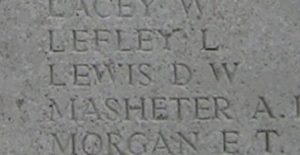
John Lewis, Private, 3348, Welsh Regiment. John was born at Llanelly Hill in 1879, the son of Edward Lewis and Margaret Lewis (nee Williams). He married Gladys Ceinwen Jenkins at Llanelly Hill in 1903 and the couple set up home at 12, Lower Rank, Pwlldu, Blaenavon, where John had gained work as a colliery horse keeper. Gladys died in 1911 and the couple’s three young children went to live with relatives at Blaenavon. John enlisted into the 1/5th Battalion, Welsh Regiment at Pontypridd soon after the outbreak of war. The battalion was a Territorial Army unit and mobilised for war in August 1914, as part of South Wales Brigade, Welsh Division. The division moved to Tunbridge Wells until the end of the month, before moving to Scotland to man the Forth and Tay Defences. On 17 April 1915 the battalion moved to Bedford, as part of the now renumbered 158 Brigade, 53rd (Welsh) Division. On 19 July 1915 the entire Division sailed from Devonport for Imbros and on 9 August 1915 landed at Suvla Bay. The infantry moved off the beaches across the Salt Lake, under shellfire, into the scrub covered Chocolate Hill, but due to a lack of maps and no knowledge of the terrain, many of the units became disorientated, and the situation became chaotic. John survived the slaughter of the landings, but the campaign soon bogged down into trench warfare and as autumn came, so did the misery of rain, snow and the inevitable sickness and disease. John took ill at the beginning of November and was evacuated off the Gallipoli peninsula aboard the Hospital Ship Letitia. He died of rheumatism and acute bronchitis whilst at sea, just before the ship docked at Malta. The body of the 36-year-old was brought off the ship and he was buried in Pieta Military Cemetery, Malta. John is also commemorated on the Blaenavon war memorial. His name is not among those on the Memorial window in St. Elli’s.
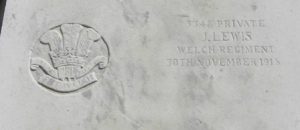
Richard Lloyd, Shoeing Smith, 72324, Royal Garrison Artillery. Richard was the son of John and Margaret Lloyd, of Penyrheol Cottage, Gilwern. He worked as a farm labourer at Pant Farm, Llanellen prior to enlisting into the Royal Garrison Artillery at Abergavenny on 11 December 1915 and was sent to No 4 Depot, RGA at Newport. After completing his training, Richard was posted to France, joining the 24th Heavy Battery and over the coming months qualified as a Shoeing Smith. Richard served for over two years on the Western Front with the battery and on 14 November 1918 was granted two weeks leave, so returned home to his parents. Sadly, he became ill and died at home of influenza and pneumonia on 26 November 1918. The 32-year-old was buried in St. Elli’s Churchyard, Llanelly.
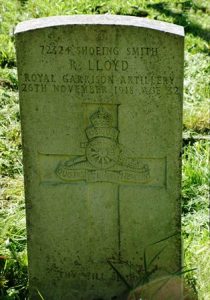
Albert Edward Makin, Private, 28934, South Wales Borderers. Albert was born at Leeds on 16 February 1898, the son of William Henry Makin and Sarah Jane Makin (nee Morgan). His father was originally from Leeds, and worked as a stone mason, and over the years the family had moved between various place, from Brecon to Abergavenny and then back to Leeds. By 1901 the family had moved back from Leeds to 5, Church Row, Chepstow, and then by 1911 Albert was residing with his aunt, the widowed Sarah Thornbury, at 6, Wilson Yard, Mill Street, Abergavenny. Albert moved to Gilwern to work after he left school, then enlisted at Brecon in the summer of 1916 into the South Wales Borderers. Upon completing his training, he was posted to Salonika to join the 8th Battalion, South Wales Borderers, which was attached to 67 Brigade, 22nd Division. The Division had been in Salonika since December 1915, helping to hold the Greek Frontier, as part of a Franco-English Force which had been sent there following the invasion of Serbia by the Austro-Hungarians. Albert was attached to the 67th Machine Gun Company after his arrival there. He was wounded during the early summer of 1918 and died of his wounds on 7 May 1918. The 20-year-old is buried in Karasouli Military Cemetery, Greece.
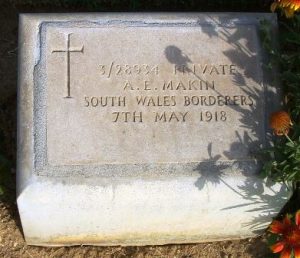
Henry Morgan, Private, 10515, King’s Shropshire Light Infantry. Henry was born in 1890, the son of Henry Morgan and Annie Eliza Eva Morgan (nee Bridges), of Ivy Cottage, Clydach, Breconshire. He enlisted at Hereford into the King’s Shropshire Light Infantry soon after the outbreak of war. Henry was drafted to France on 12 November 1914 and joined the 1st Battalion, King’s Shropshire Light Infantry, which was attached to 16 Brigade, 6th Division. The division had landed at St. Nazaire on 10 September 1914, in time to reinforce the hard-pressed BEF on the Aisne, before the whole army was moved north into Flanders from 14 October. The 6th Division moved to positions near Armentieres, at Bois Grenier where it remained over the coming months. At the end of May 1915, the division was relieved from here and transferred to positions in the Ypres Salient, taking over positions at Wieltje and Potijze. The division became caught up in the terrible fighting which followed the German flamethrower attack at Hooge during June 1915, but the line held, and the division remained in the same sector over the coming months. Henry was killed during a routine spell in the trenches at La Brique on 17 October 1915. The 25-year-old was buried in La Brique Military Cemetery No.2, Belgium.
Trevor George Nash, Sapper, 229838, Royal Engineers. Trevor was born at Blaenavon in 1897, the son of Henry Nash and Juliette Emily Nash (nee Duck). By 1911 the family had moved to 110, St Helens Road, Abergavenny, where Trevor was educated. The family moved to Pine Grove, Maesgwartha, Gilwern prior to the war. Trevor worked as a Clerk for the London and North Western Railway at Abergavenny prior to enlisting in the town into the Royal Engineers on 16 February 1916 but was then placed on the Army Reserve. He was mobilised on 21 February 1917 and joined the Railway Operating Division, Royal Engineers at Camp Bordon, Hampshire. He then began training in preparation to move out to the Western Front. Sadly, soon after arriving at Bordon Trevor fell ill. He was taken to the Military Hospital at Fremisham Hill, where he died of tuberculosis on 22 February 1917. The body of the 19-year-old was brought home and he was buried in All Saints Churchyard, Clehonger, in Hereford, beside his mother who had died two years earlier. His name is not among those on the Memorial window in St. Elli’s, but has been added on the later plaque below.
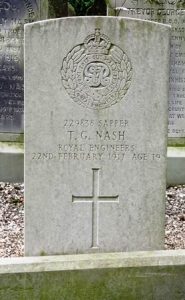
William Hayden Phillips, Private, 81015, The King’s (Liverpool Regiment). William was born in 1897, the son of William Phillips and Clara Phoebe Phillips (nee Williams), of Heathbush, Clydach, Breconshire. He enlisted at Newport into the South Wales Borderers during the early months of 1916, and after completing his training was posted to the 2nd (Garrison) Battalion, The King’s (Liverpool Regiment). The battalion had been formed at Pembroke Dock in November 1915, before embarking for Egypt in March 1916 and moved to Salonika in January 1917 on Lines of Communication work. William had only been in Salonika for little over a month when he was killed on 27 February 1917. The 20-year-old is buried in Salonika (Lembet Road) Military Cemetery, Greece.
Thomas Edward Gordon Pickering, Private, Rhodesian Horse. Thomas was born in Gilwern in 1891, the son of Alfred Truscott Pickering and Edith Winifred Pickering (nee Pierce), of Auckland House. He left home as a young man to work in Rhodesia and whilst there enlisted into the Rhodesian Horse. Thomas was back home on holiday visiting his family at Gilwern during the time of the 1911 Census, but soon afterwards returned to Victoria, Rhodesia. He must have served throughout the war with the Rhodesian Horse but remained in Africa throughout the conflict. A month prior to the Armistice Thomas took ill and was taken to Holly Lodge Hospital, in the Cape. He died there of influenza and pneumonia on 1 November 1918. The 27-year-old was buried in Maryland, Southern Rhodesia. Nothing further is known of Thomas, as he is not commemorated by the CWGC. The Gilwern War Memorial states that he served with the South Wales Borderers, but there are no records to prove this.
Thomas Arthur Powell, Lance Corporal, G/24807, The Queen’s Own (Royal West Kent Regiment). Thomas was born Clydach, Breconshire in 1896, the son of Sarah Powell. He lived at Adpar, Newcastle Emlyn prior to enlisting into the Welsh Horse Yeomanry. He was among a number of men transferred from the Welsh Horse to the 7th Battalion, Queen’s Own (Royal West Kent Regiment) prior to its embarking for France on 27 July 1915 as part of 55 Brigade, 18th (Eastern) Division. The division didn’t see its first major action until July 1916 when it took part in the Battle of Albert, but then fought through the remainder of the Somme offensive. It followed the German withdrawal to the Hindenburg Line in March 1917 and in May took part in the Third Battle of the Scarpe, which was part of the Arras Offensive. July 1917 saw the Division at Ypres, where they took part in the Battle of Pilckem, where they helped capture Westhoek. Thomas was killed in action here on 3 August 1917, aged 21. He has no known grave and is commemorated on the Ypres (Menin Gate) Memorial, Belgium.
William Henry Price, Gunner, 13128, Royal Field Artillery. William was born at Clydach, Breconshire in 1885, the son of Benjamin Price and Emma Price (nee Lewis). By 1891 the family had moved to 118, Abertillery Road, Blaina, where his father had found work as a coalminer. William also worked as a coalminer after leaving school, but soon after the outbreak of war left his job to enlist at Newport into the Royal Field Artillery. He was then posted to France, joining the 30th Battery, 39th Brigade, Royal Field Artillery. The battery had been in France since August 1914 and was attached to the 1st Division. William probably joined it in the summer of 1916, during the time of the Battle of the Somme. The division wintered on the Somme, then early in 1917 moved to the Flanders coast, to prepare for a possible offensive along the coast, code-named ‘Operation Hush’. The divisional artillery set up near Coxyde and over the coming months carried out artillery shoots against strategic German targets, as well as carrying out artillery support for the divisions infantry units as they carried out trench raids. William was killed in action here on 3 July 1917, during a relatively quiet day. The 32-year-old is buried in Coxyde Military Cemetery, Belgium. As it transpired, Operation Hush was called off and the 1st Division was later moved to Ypres to take part in the latter stages of the Passchendaele offensive. His name is not among those on the Memorial window in St. Elli’s, but has been added on the later plaque below.
James Sutherland, Private, 35325, Welsh Regiment. James was the son of Thomas Sutherland and Mary Margaretta Sutherland (nee Lewis), of Maesgwartha, Gilwern. He worked as a warehouse assistant at Brynmawr prior to enlisting into the Welsh Regiment at Brynmawr and in the spring of 1916 was drafted to the Middle East, joining the 8th Battalion, Welsh Regiment, which was the Pioneer Battalion to the 13th (Western) Division. The Division had fought during the Gallipoli campaign before being evacuated on 8 January 1916, and by 31 January was concentrated at Port Said, where it held forward posts in the Suez Canal defences. On 12 February 1916 the Division began to move to Mesopotamia, to strengthen the force being assembled for the relief of the besieged garrison at Kut al Amara. By 27 March, the Division had assembled near Sheikh Saad and came under orders of the Tigris Corps, and then took part in the attempts to relieve Kut. However, after these efforts failed and Kut fell, the British force in the theatre was built up and reorganised. The Division then fought at the Battle of Kut al Amara, then at the capture of the Hai Salient and the capture of Dahra Bend. It then took part in the passage of the Diyala, in the pursuit of the enemy towards Baghdad, and part of the Division became the first British troops to enter Baghdad. During the rest of March and April 1917, operations were undertaken to consolidate the position won at Baghdad, by pushing north across Iraq. James died of heatstroke in Mesopotamia on 24 July 1917. The 21-year-old is buried in Baghdad (North Gate) War Cemetery, Iraq.
Arthur Emrys Thomas, Private, 71984, Royal Army Medical Corps. Arthur was born in Cwmtillery in 1894, the youngest child of Thomas Thomas and Mary Thomas (nee Evans). He was raised with his brother Philip Thomas and sister-in-law Fanny Elizabeth Thomas (nee Witch) at Waterfall Cottage, Gilwern, then by 1911 Arthur was lodging with another older brother at Blackrock, Clydach, where he was working as a coal miner. He enlisted into the 38th (Welsh) Division, Royal Army Medical Corps at Brynmawr on 25 October 1915 and was posted to Brecon for his medical before entraining to Aldershot for training. Arthur was drafted to Egypt on 3 February 1916 and upon his arrival was attached to the 1/6th Battalion, Essex Regiment, which was attached to 161 Brigade, 54th (East Anglian) Division. The Division had been evacuated from Gallipoli just over a month before Arthur arrived in Egypt, then took part in the campaign against the Senussi tribesmen when it moved into positions to guard the coast railway from Alexandria to Da’aba. The Essex battalions were relieved on 4 March 1916 and moved into the Southern Section of the Suez Canal Defences. During the remainder of 1916, the units of the 54th Division were steadily brought up to strength and in January 1917 began assembling for the opening of the Palestine Campaign before advancing across the Sinai Desert in readiness to take part in the First Battle of Gaza. The battle opened on 26 March 1917, with the 53rd (Welsh) Division leading the way and 161 Brigade followed in support before taking Green Hill. Due to poor communication, the 53rd Division withdrew during the night, leaving 161 Brigade isolated before it too was forced to withdraw, suffering heavy casualties. Arthur was wounded during the battle and was evacuated to hospital at Deir el Belah, where he died of his wounds on 29 March 1917. The 23-year-old is buried in Deir El Belah War Cemetery, Israel. His name is not among those on the Memorial window in St. Elli’s, but has been added on the later plaque below.
Edward Thomas Watkins, Private, 26225, South Wales Borderers. Edward was born in Llanelly in 1879. He had married in 1905 and lodged with his wife Ellen Watkins at Foundry House, Alma Road, Brynmawr. Edward worked as a labourer prior to enlisting into the South Wales Borderers at Brynmawr in 1915. He was drafted to France in the spring of 1916 and was posted to the 1st Battalion, South Wales Borderers, which was at Loos attached to 3 Brigade, 1st Division. During July 1916 the Division moved south, to join the great Somme offensive, and the 1st SWB reached Albert by 10 July, taking up billets in the town. On the morning of 15 July, the 1st SWB received orders to proceed via the recently captured Mametz Wood to the new front line, taking over support positions behind the 2nd Welsh near Bazentin-le-Petit Wood and remained in reserve whilst 3 Brigade launched an assault against Bazentin Ridge. On 18 July the 1st SWB withdrew to the old German front line near Lozenge Wood before moving back to Albert via Becourt Wood where the men enjoyed a cold bath in the river Ancre. The 1st SWB then endured another short spell in the line before moving back to Millencourt on 26 July to rest and did not proceed into the battle zone again until 15 August, when the battalion marched via Becourt Wood and on 20 August moved back into the front line at Bazentin-le-Petit Wood, when 3 Brigade relieved 1 and 2 Brigades. The division then saw further heavy fighting on the flank of the Australian Corps during the Battle of Pozieres, then saw further fighting during the Battles of Flers-Courcelette and Morval. After wintering on the Somme, the division followed the German withdrawal to the Hindenburg Line in early 1917, before being briefed for an operation on the Flanders Coast and moved there during the summer of 1917. The operation, Operation Hush, was a planned offensive along the coast if the Passchendaele offensive was successful but was called off when the troops at Passchendaele became bogged down in the mud and the 1st Division was instead transferred to Ypres in October 1917. The Division took up positions near Valour Farm, on the lower edge of the ridge, by 9 November and prepared to launch an assault on the following morning. The objectives were a series of ruined farms which had been fortified by the Germans and at dawn on 10 November 1917 the Division launched its assault. The men arose from the trenches and began to advance through thick mud, but the men got caught up in their own artillery barrage. Edward was killed in action during this assault on Passchendaele Ridge on 10 November 1917. The 38-year-old has no known grave and is commemorated on the Tyne Cot Memorial, Belgium. Edward is not commemorated on the memorial window nor on the additional plaque in St. Elli’s.
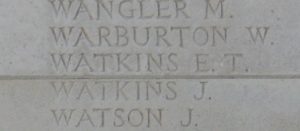
William John Watkins, Private, 26244, South Wales Borderers. William was born in 1895, the son of Thomas Watkins and Susannah Watkins (nee Bowen), of Fair View Bungalow, Llanelly Hill. His mother died the following year, so William and his two sisters were raised by their father alone, until he remarried to Harriett Collette in 1902, and three further siblings were born before Harriett sadly died in 1910. William worked as a coalminer prior to the war. He enlisted at Brynmawr into the South Wales Borderers on 10 November 1915 and after completing his training was drafted to France in the summer of 1916, joining the 1st Battalion, South Wales Borderers, which was attached to 3 Brigade, 1st Division. The division moved from Loos to the Somme sector at the beginning of July 1916 and took part in heavy fighting for Bazentin Ridge. The division saw further heavy fighting on the flank of the Australian Corps during the Battle of Pozieres, then saw further fighting during the Battles of Flers-Courcelette and Morval. After wintering on the Somme, the division followed the German withdrawal to the Hindenburg Line in early 1917, before being briefed for an operation on the Flanders Coast and moved there during the summer of 1917. The operation, Operation Hush, was a planned offensive along the coast if the Passchendaele offensive was successful but was called off when the troops at Passchendaele became bogged down in the mud and the 1st Division was instead transferred to Ypres in October 1917. William was wounded during the fighting for Passchendaele Ridge at the beginning of November and was evacuated to hospital near the coast at Wimereux, where he died of his wounds on 20 November 1917. The 22-year-old is buried in Wimereux Communal Cemetery, France. William is also commemorated on the Abergavenny war memorial.
David William Whitby, Guardsman, 1403, Welsh Guards. David was born at Clydach, Breconshire in 1889, the son of Frederick William Whitby and Elizabeth Whitby (nee Davies). He married Blodwen Jones in 1913 and the couple set up home at Cwm Nant Gan, Llanelly Hill, where they had two sons, Maldwyn and David William, born over the next two years. David worked as a coalminer prior to the war. He enlisted into the newly formed 1st Battalion, Welsh Guards soon after its formation by Royal Warrant of 26 February 1915, at White City, before landing at Le Havre on 18 August 1915, becoming attached to 3rd Guards Brigade, Guards Division. The Division saw its first major action during the Battle of Loos, which began on 25 September 1915. During the opening day, the Guards Division began moving into position, watching the terrible scenes in front of them, before launching its own attack on the following morning. At around 18.00 that day the Welsh Guards received orders to attack a feature called Hill 70, and as the men slowly made their way forwards, darkness fell. As soon as the battalion reached the top of the Hill, German machine-gunners opened up a murderous fire on them, forcing the men to dig into the many shell holes littering the crest, before retiring to positions just below of the crest, where the survivors dug-in. David appears to have been wounded and taken prisoner by the Germans at some time during the night of 26-27 September. He died of his wounds in the German hospital at St. Clotilde, in Douai on 1 October 1915. The 26-year-old was buried in Douai Communal Cemetery, France.
Albert James White, Private, 290465, Monmouthshire Regiment. Albert was the son of William and Mary Annie White, of Maesgwartha, Gilwern. He enlisted into the 3rd (Reserve) Battalion, Monmouthshire Regiment at Abergavenny on 17 September 1914 and was posted to Northampton with the 68th (2nd Welsh) Division. Albert embarked for France at Southampton on 13 March 1917 and was posted from the Infantry Base Depot at Rouen to the 1st Battalion, Monmouthshire Regiment, which was the Pioneer Battalion to the 46th (North Midland) Division. Albert joined the battalion at Ecqueldecques, near St. Hilaire, where it was refitting. The Division was in the Bully-Grenay Sector near Loos and in May 1917 fought in the Battle of Arras, taking part in the Battle of Hill 70. The Division remained here over the coming months, whilst the fighting moved north to Passchendaele, so had a relatively quiet time for the remainder of 1917, with the 1st Monmouth’s kept busy on work around Mazingarbe and Cambrin. The battalion then began work around Sailly-Labourse in September 1917, remaining here for the winter. Albert was taken ill in February 1918 and was evacuated to the 34th Field Ambulance before being sent to the 1st Casualty Clearing Station at Chocques, where he died of appendicitis on 28 February 1918. The 21-year-old is buried in Chocques Military Cemetery, France.
World War Two, 1939-1945
Mervyn Tasse Andrews, Driver, 1922152, Royal Engineers. Mervyn was born in 1919, the son of Frederick William Andrews and Jane Andrews (nee Field), of Library Cottage, Clydach. He enlisted into the Royal Engineers soon after the outbreak of war and was posted to 59 Bomb Disposal Section, Royal Engineers. The unit was one which had been formed after the outbreak of war specifically to deal with unexploded German bombs, an obviously tremendously hazardous role which required men with nerves of steel. Mervyn was killed whilst attempting to defuse an unexploded bomb behind 117, Welwyndale Road, Sutton Coldfield, Birmingham on 25 August 1940, when the bomb exploded, killing seven sappers and wounding another who subsequently died. The bomb had been dropped during a terrible two-day period of bombing which saw the Bull Ring destroyed. The remains of the 20-year-old were brought home and he was buried in St. Elli’s Churchyard, Llanelly.
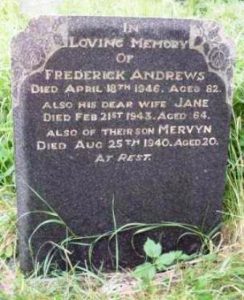
Frank Cheatle, Corporal, 4913893, South Staffordshire Regiment. Frank was born at Walsall in 1916, the son of John Cheatle and Sophia Cheatle (nee Powell). He had enlisted into the army soon after the outbreak of war and was posted to the 2nd Battalion, South Staffordshire Regiment. Frank married Dorothy Rose Marshall, of Clydach, in 1941. The 2nd Battalion, South Staffordshire Regiment was on garrison duty in India when war broke out and arrived back in England on 17 July 1940, as part of the 31st Independent Infantry Brigade, at Wheatley in Oxfordshire. The battalion was then converted to a glider infantry role, joining the 1st Airlanding Brigade, 1st Airborne Division and embarked for North Africa in May 1943. The 1st Airlanding Brigade took off from airfields in North Africa on 9 July 1943 in gliders, towed by a mixture of American C-47 Dakotas and RAF tugs as part of Operation Ladbroke, which aimed to cut the German forces in Sicily prior to an amphibious landing on the following morning. Frank was killed in Sicily on the night of 9 July 1943. The 27-year-old is buried in Syracuse War Cemetery, Sicily.
Brinley Evans, Lance Corporal, 4197949, King’s Shropshire Light Infantry. Brinley was born at Clydach, Breconshire on 8 March 1918, the son of Alfred Thomas Evans and Mary Evans (nee Price). The family had moved to Troed-y-Wennol, Govilon, Monmouthshire prior to the war, where Brinley and his father both worked as coalminers. Brinley enlisted into the army and was posted to the 2nd Battalion, King’s Shropshire Light Infantry. The 2nd Battalion began the war stationed in Jamaica and Bermuda, before returning to Europe to join the 185th Infantry Brigade, which included the 2nd Battalion, Royal Warwickshire Regiment and the 1st Battalion, Royal Norfolk Regiment, of the 79th Armoured Division. The 185th Brigade then transferred to the 3rd Infantry Division in April 1943 and began to prepare for the invasion of Sicily. Plans then changed and the division returned to England to prepare for the Normandy Landings, which took place on D-Day, 6 June 1944. The division then took part in the efforts to capture the town of Caen but failed due to a heavy resistance put up by the elite German 21st Panzer Division. Brinley was killed in Normandy on 1 July 1944. The 28-year-old was originally buried on the battlefield, near the village of Cheux, but in September 1945 his grave was exhumed, and he was re-interred in St. Manvieu War Cemetery, Cheux, France.
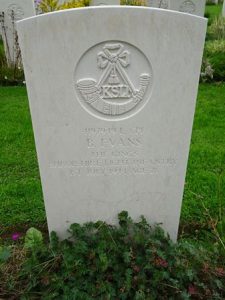
Joseph Fear, Sergeant, 2216622, Royal Air Force Volunteer Reserve. Joseph was the son of Joseph Fear and Winifred Fear (nee Pritchard), of Maesgwartha, Gilwern. He enlisted into the Royal Air Force Volunteer Reserve and after training as a Flight Engineer was posted to 207 Squadron, Royal Air Force, which was a heavy bomber squadron, based at RAF Spilsby, in Lincolnshire. On the night of 7 July 1944, Joseph took off from Spilsby aboard Avro Lancaster I, Serial LM218, which formed part of a large force despatched to bomb the V-1 Storage Site at St Leu-D’esserent. During the early hours of 8 July 1944, the Lancaster crashed near Haudricourt, some three miles from Aumale, with the loss of five of her crew of seven. Joseph was 20 years old when he was killed in the crash that morning. He is buried alongside his fellow crewmen in Haudricourt Communal Cemetery, France.
Henry Hill, Gunner, 1122050, Royal Artillery. Henry was born at Brynmawr on 21 July 1905, the son of Joseph Hill and Margaret Ann Hill (nee Davies). He married Maria May Roberts in 1929 and the couple set up home at Starving Point, Llanelly Hill. Henry worked as a coalminer prior to the war. He enlisted into the Royal Artillery and was posted to the 13th Anti-Tank Regiment, Royal Artillery. The regiment served as the anti-tank regiment of 2nd Infantry Division in France until its evacuation from Dunkirk in May 1940. The regiment was sent to India with the division on 15 April 1942, but in July was transferred to Egypt, joining the 5th Indian Division. The regiment then fought in North Africa until being transferred to Syria in May 1943. The regiment then returned to Egypt, before sailing for Italy in March 1944 to join the great Allied offensive in Italy. Henry was killed in Italy on 13 July 1944. The 38-year-old was originally buried on the battlefield, but in April 1945 his grave was exhumed, and Henry was re-interred in Assisi War Cemetery, Italy.
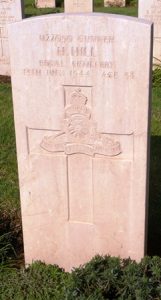
Donald Arthur Ivor Lewis, Sapper, 2155478, Royal Engineers. Donald was born on 17 June 1922, the son of William Lewis and Jessie Lewis (nee Howe), of Twynwenallt Farm, Gilwern. He worked as a carpenter’s labourer at Gilwern prior to enlisting into the Royal Engineers and was posted to 271 Field Company, Royal Engineers, which was attached to the 46th (North Midland) Division. The Division fought in North Africa with the 8th Army, before taking part in the liberation of Sicily in 1943, then landed in mainland Italy to begin the long slog northwards to drive the Germans out of the country, which had by now surrendered. Donald was killed in Italy on 4 September 1944 during the crossing of the Foglia River, which was part of the German Gothic Line defensive system. The 22-year-old was originally buried on the battlefield, but in May 1945 his grave was exhumed, and Donald was re-interred in Montecchio War Cemetery, Italy.
Victor Irving Powell, Gunner, 4081131, Royal Artillery. Victor was born on 3 November 1915, the son of William Henry Powell and Elizabeth Maud Powell (nee Lloyd), of 1, Castle Cottages, Gilwern. He worked as a dumper driver at Gilwern prior to the war. Victor married Frances Margaret Beryl Griffiths, of Holdenhurst, Cardigan, at Cardigan in 1941. Victor enlisted into the Royal Artillery and was posted to 311 Battery, 90th Light Anti-Aircraft Regiment, Royal Artillery. The battery took part in the North African campaign. Victor was killed in Tunisia on 20 April 1943, aged 27. He is buried in Medjez-El-Bab War Cemetery, Tunisia.
David Pryce Rawlings, Sergeant, 526314, Royal Air Force. David was born on 30 March 1915, the son of William Joseph Rawlings and Margaret Rawlings (nee Lewis), of Wilma Shop, Gilwern. He enlisted into the Royal Air Force prior to the war and by 1939 was based at RAF Filton, where he was training as a pilot. David lodged at 37 Callicroft Road, Patchway, Bristol whilst based at Filton. Upon completing his training, he was posted to 148 Squadron, Royal Air Force, which had reformed at RAF Scampton on 7 June 1937, equipped with the Hawker Audax and the Vickers Wellesley. David was then posted to RAF Luqa at Malta with the Wellington Detachment from the Squadron. On 4 November 1940, David took off from Luqa flying Vickers Wellington Ic, Serial R1094, on a raid on the Italian town of Naples. The Wellington lost power on take-off and crashed into houses at Qormi, killing David and his entire crew. The 25-year-old was buried with his fellow crewmen in Malta (Capuccini) Naval Cemetery, Malta.
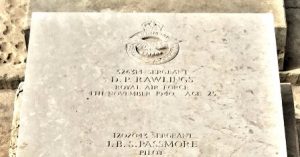
Jack Rogers, Corporal, 567816, Royal Air Force. Jack was born on 5 September 1918, the son of William Rogers and Catherine Rogers (nee Williams), of Waenlapra, Llanelly Hill. He left school to enlist into the Royal Air Force and was posted to 62 Squadron, RAF. The squadron was posted to Singapore in August 1939 and moved to Alor Star in northern Malaya in February 1940. Following the Japanese invasion of Malaya on 8 December 1941 the squadron was evacuated to Butterworth but was virtually destroyed when the base was attacked by Japanese aircraft the following day. The remnants of the squadron then moved to Taiping, Perak, however the Japanese were now on the ascendency, so the squadron moved back to Singapore where it re-equipped with Lockheed Hudson’s, before moving again to Palembang, Sumatra in January 1942. The squadron was evacuated to Semplak, in Java when Sumatra came under attack by the Japanese. Jack was taken prisoner by the Japanese when Java fell on 20 March 1942 and was taken to a POW Camp at Ambon. Over the coming years the Allies began recapturing many of the territories captured by the Japanese, so in October 1944 the Japanese rounded up their prisoners in Ambon and crowded them aboard the Hellship, Maros Maru. The ship set sail for Soerabaya, and the men, most already weak and ill from two brutal years in captivity, were held in terrible conditions crowded below deck. Jack died of beri beri aboard ship on 31 October 1944 and was buried at sea. He was among some 300 men to die in these brutal conditions during the voyage. The 26-year-old has no known grave and is commemorated on the Singapore Memorial.
James Kenneth Sutherland, Captain, 79853, Royal Army Medical Corps. James was the son of James Sutherland and Janet Sutherland (nee Rorrison), of Glen Caion, Gilwern. His parents were both Scottish born but had lived at Gilwern for many years. James studied medicine at Edinburgh after leaving school and qualified M.B.Ch.B., M.R.C.O.G. He practised at Edinburgh after qualifying as a doctor and married a fellow Doctor, Joan Kennedy Cunningham at St. Andrews Church, Edinburgh on 16 September 1939. James was by then serving as a Lieutenant in the Royal Army Medical Corps, after having volunteered following the outbreak of war. He was posted to France with a Royal Artillery unit of the BEF and was wounded during the withdrawal to Dunkirk. Upon being brought ashore in England, James was taken to Ashbridge Hospital, Berkhamsted, where he died of his wounds on 27 May 1940. The remains of the 29-year-old were brought home and he was buried in St. Elli’s Churchyard, Llanelly.
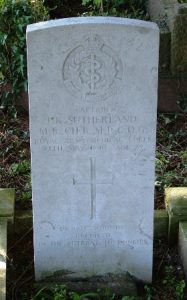
Arthur Reginald Thomas, Gunner, 14320807, Royal Artillery. Arthur was born at Clydach in about 1923. He enlisted into the Royal Artillery and was posted to the elite 3rd Airlanding Anti-Tank Battery, Royal Artillery. The battery had formed at Marlborough Barracks, Bulford, Wiltshire on 9 May 1943, the bulk of its men coming from ‘C’ Battery, 103rd Anti-Tank Regiment, Royal Artillery and was formed to provide defence to the parachute brigades of the 6th Airborne Division. Members of the battery landed in Normandy with the 6th Airborne Division on D-Day, tasked with the capture of the Caen canal and Orne River bridges, as well as in Operation Tonga, the Battle of Merville Gun Battery, and Operation Mallard. Some guns of the battery came over aboard Landing Craft during the morning to join the fray. The 6th Airborne Division moved back to Britain after the capture of Bréville-les-Monts, during a bloody battle which ended on 13 June and returned to Britain to rebuild. On 23 December 1944 the division moved to Belgium, to help counter the German breakthrough, known as the Battle of the Bulge and once the Germans had been stopped, advanced into Holland. Where the division held the area along the River Maas between Venlo and Roermond. Near the end of February 1945, the 6th Airborne Division returned to England to prepare for another airborne mission; to cross the river Rhine, during an operation code-named Operation Varsity and Operation Plunder. The airborne operation was preceded by two days of bombing by the RAF and USAAF, then on 23 March some 3,500 artillery guns targeted the German positions. That evening an amphibious assault was carried out across the Rhine by the 21st Army Group. The 6th Airborne Division was assigned to the U.S. XVIII Airborne Corps, serving alongside the American 17th Airborne Division, taking part in the largest Allied airborne operation of the war as the combined force landed in drop zones on the east side of the Rhine near Hamminkeln and Wesel in Germany. Arthur took off from England with the 3rd Airlanding Anti-Tank Battery on 24 March 1945 and landed near Hamminkeln. He was killed in action that same day, 24 March 1945, during ferocious fighting. The 21-year-old was originally buried in Hamminkeln Cemetery, Germany, but in May 1947 the war graves in the cemetery were exhumed and Arthur was re-interred into Reichswald Forest War Cemetery, Germany.
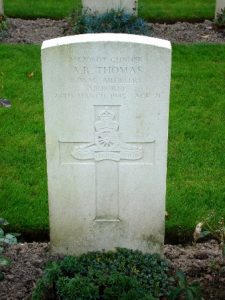
William George Griffith Thomas, Lance Serjeant, 808007, Royal Artillery. William was born at Clydach on 18 November 1912, the son of Benjamin George Thomas and Ellen Thomas (nee Charles). He married Irene Emily Born at Woolwich in 1937 and the couple set up home at Plumstead, London. William enlisted into the Royal Artillery soon after the outbreak of war and was posted to Singapore in December 1940 to join the 9th Coast Regiment, Royal Artillery. His wife then went to live with his parents, who had by now moved to the Railway Inn, at Clydach. The regiment formed part of the formidable defensive system for the strategically important city of Singapore. The Japanese invaded Malaya and Thailand from Indochina on 8 December 1941 via an amphibious assault, in conjunction with their raid on the American base of Pearl Harbour, and swiftly forced Thailand to capitulate. This allowed the Japanese to concentrate their efforts on advancing into Malaya and Two days later, Force Z, consisting of the battleship HMS Prince of Wales, the battlecruiser HMS Repulse and several destroyers, was sunk by Japanese aircraft and the fortress of Singapore was soon under attack. January 1942 was a month of ferocious fighting for Singapore and many atrocities were carried out by the invading Japanese as, bit by bit, the garrison succumbed. Despite overwhelming superiority in troop numbers, Singapore was surrendered to the Japanese by Lieutenant-General Arthur Percival on 15 February 1941 and some 85,000 Allied troops were marched into captivity. The Coastal Batteries had been destroyed three days earlier and the garrison had fought as infantry right up until the surrender, its survivors being marched into captivity at Changi. William was among a large number of prisoners shipped to French Indochina to be used as forced labour and was taken to a POW camp near Saigon. He survived for over three years in terrible conditions before dying in captivity on 13 August 1945, reportedly of appendicitis. The 32-year-old was originally buried in Saigon Military Cemetery, but in March 1954 the burials within the cemetery were exhumed and William was re-interred in Kranji War Cemetery, Singapore.
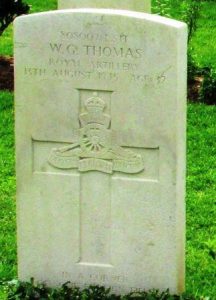
Albert Henry Wheeler, Private, 4078953, South Wales Borderers. Albert was born on 27 January 1916, the son of Richard George Henry Wheeler and Sarah Wheeler (nee Palliser), of Llangattock. He married Florence May Hancocks at Llangattock in the winter of 1941. Albert enlisted into the Monmouthshire Regiment but was posted to the 2nd Battalion, South Wales Borderers. The battalion was a regular army unit and was in Northern Ireland at the outbreak of war. In December 1939 the battalion left Northern Ireland and joined the 148th Infantry Brigade, 49th (West Riding) Infantry Division, then in April 1940 transferred to the 24th Guards Brigade (Rupertforce), before landing in Norway to take part in the Norwegian Campaign. The battalion was among the first British troops to see action against the Germans during the war. The Norway campaign ultimately failed, and the brigade was evacuated back to Britain. The 2nd SWB then transferred to the 37th Independent Infantry Brigade, which was redesignated as the 7th Infantry Brigade the following day and remained with the brigade until 1 March 1944 when it transferred to the newly created 56th Independent Infantry Brigade, together with the 2nd Essex and the 2nd Gloucester’s, before beginning training for the invasion of Normandy. The battalion became the only Welsh battalion to take part in the Normandy landings on 6 June 1944, landing at Gold Beach under command of the 50th (Northumbrian) Infantry Division. The division then took part in the fighting for Normandy and following the breakout, took part in the advance through Northern France into Belgium and Holland over the coming months. Following the closure of Operation Market Garden, the division spent an arduous and miserable winter on the ‘island’- a waterlogged section of land between Arnhem and Nijmegen. Albert was killed here on 23 November 1944. The 28-year-old is buried in Venray War Cemetery, Netherlands.
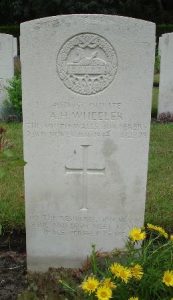
Arthur Selwyn Whiteley, Corporal, 3909917, South Wales Borderers. Arthur was the son of James Henry Whiteley and Beatrice Gwendoline Whiteley, of Crickhowell Road, Gilwern. He enlisted into the South Wales Borderers and was posted to the 2nd Battalion, South Wales Borderers. The battalion had taken part in the Battle of Norway in 1940 before its survivors were evacuated back to Britain and spent most of the war in Britain. It then began preparing to take part in the Normandy Landings, being the only Welsh unit selected to land on the opening day, D-Day, on 6 June 1944. The battalion saw heavy fighting during the landings, when it seized a radar station and by nightfall the bridge at Vaux-sur-Aure had been captured intact. The battalion saw heavy fighting around Caen later in the Normandy campaign, before taking part in the drive through Northern France into Belgium and Holland, before crossing the Rhine into Germany in the spring of 1945. By now Arthur had been invalided home and he died at Basingstoke on 16 April 1945. The remains of the 26-year-old were brought home and he was buried in Llanwenarth Baptist Chapelyard.
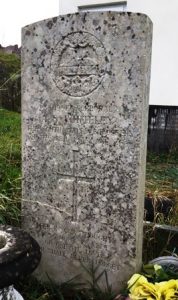
Dennis Albert Williams, Driver, T/14664656, Royal Army Service Corps. Dennis was born in 1924, the son of William Alfred Williams and Kate Victoria Williams (nee Chivers), of Gelli Felen, Llanelly Hill. He enlisted into the army as soon as he left school and was posted to the 633rd General Transport Company, Royal Army Service Corps. The company was a DUKW company and was formed to ferry troops onto the Normandy landing beaches. Dennis probably took part in the Normandy Landings on D-Day, 6 June 1944, where one of the DUKW’s of his company ferried the British commander, Bernard Montgomery ashore, then his company would have taken part in the advance north through Belgium into Holland, towards the Rhine over the coming months. His company took part in Operation Market Garden later that year. Then in the following spring played an important role during Operation Varsity, the Rhine crossings, on 24 March 1945. Dennis died during the advance which followed, near Lunenburg, on 6 May 1945. He was originally buried near the town, but after the war his grave was exhumed and the 21-year-old was re-interred in Hamburg Cemetery, Germany.